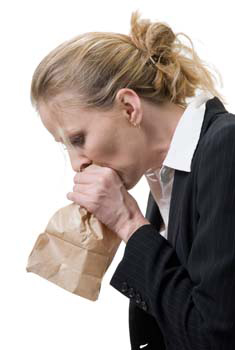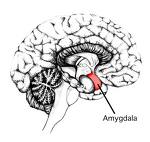|
Panic Attacks A form of Anxiety Disorder``Symptoms jump you from behind without warning. Your heart begins to beat wildly, your forehead is suddenly wet with perspiration, your hands tremble, your throat dries and swallowing is almost impossible. Your mind races to grab control of your body, but even as you tell yourself to ‘stay calm’ it happens you look for the nearest door, any door, so you can run away, far away, because that’s the only thing that seems to help.’’ ``Take Control of Your Life – A Complete Guide to Stress Relief`` p.198
Any unexpected high-stressing situation can set these terrifying feeling of apprehension…For example, if you are the victim of a traumatizing accident or of violence; an unexpected and unwanted guest breaks-into your private environment vandalizing; those feelings are normal and even life-saving as they create the fight-or-freight mobilizing you into the protection and safety reaction. Picture these same symptoms in those circumstances of normal relaxation – either watching television or in the ones of everyday journal tasks such as driving a vehicle or grocery shopping - and these fight-or-flight symptoms all of a sudden makes you loose peace and serenity, makes you panic and fear for your life! As irrational as this may appear to some people, this situation is very much real, in the life of millions of citizens. It might even be yours or a friend of yours!(There are approximately 2.4 millions or 1.7% of the American population suffering of panic disorder in 2005)) As we journey together in this encounter, we will demystify the panic disorder, its causes and triggers, its symptoms as well as the therapeutic approaches available for assistance.
DEFINITION OF PANIC DISORDER
``The work panic is derived from the name of a Greek god named Pan - a lonely and moody cloven-footed dwarfish who loved to play practical jokes to humans. If a wanderer happened to pass the cave where he was hiding, Pan would jump out with a shrill and a terrifying scream. The acute terror felt by the wanderer – is called ``panic``. ``Panic Disorder – The Facts by Authors Stanley Rachmand and Padmal de Silval ``
TRIGGERS OF PANIC DISORDER ``The first time a panic attack happens, the person often believes he or she is having a heart attack, going crazy or losing control. If the episode recurs within days or weeks – the person begins to fear panic itself and tries to reduce the risk of panic by avoiding what they believe triggers the attacks. `` ``These threats don’t require physical responses. Unfortunately, our bodies respond to any threat as if does require an immediate physical response.’’ This explains the misunderstanding and the apparent irrational fear when people will experiment an attack anywhere – whether in front of a television set or in a mall. ``For the individual, the big confusion starts when after a few visits for medical assistance – and receiving a perfectly healthy condition diagnosis, he begins to doubt about his/her mental sanity. Even more so, he/she fears the location or situational circumstances that contributed in activating this panic attack and he/she begins to isolate him/herself for safety reasons.`` Don’t Panic: Taking Control of Anxiety and Attacks In panic disorder ``The person repeatedly experiences unexpected episodes of panic. In addition, at least one of the episodes is followed by persistent worries, lasting a month or more, of having another panic or by a significant change in the lifestyle or behaviour related to the panic attacks. ``During episodes at least four of the following sensations/feelings are experienced:
Some or all these body signals are accompanied by high anxiety and apprehension. In cases of panic disorder the episodes may occur as often as daily or several times per week. After the first episode of unexpected, inexplicable panic, medical reassurance is usually sufficient to provident temporary relief and a sense of calm. When the subsequent episodes occur conventional reassurance is of limited value. The person begins to fear that more specialist treatment may be required. American Psychiatric Association (1994) 4TH EDITION Some of the areas that individuals concerned with numerous panic attacks fear are the following: We will elaborate further about phobias in our next encounter. Understanding the function of the mind helps to visualize the conditioning of this emotional reaction. Symptoms are controlled by the nervous system. In our encounter about signs and symptoms of depression we’ve illustrated how malfunctioning neurotransmitters can be one of the causes of depression. For more information click on this link:
For more information about depression signs & symptoms Dr Reneau Peurifoy, in his book : ‘’Anxiety, Phobias & Panic – A Step-by-Step Program for Regaining Control of Your Life (p.5-6) illustrates the nervous system as such:‘’ The system is divided into two parts: a)the voluntary nervous system (somatic system) It is composed of nerves that connect to the muscles that control movement and your various senses. This system sends information from your eyes, ears, and other senses to the brain and controls actions that require thought, such as raising your arm or walking. b)the autonomic nervous system It is composed of all the nerves that connect to your internal organs and glands and controls all the automatic activities that occur in your body, such as digestion and breathing. The autonomic nervous system is broken into two parts: 1. Sympathetic Division This part is responsible for what is commonly referred to as the fight or flight response, is designed to activate the body quickly and prepare it to fight or flee from danger almost instantaneously. 2.Parasympathetic division This part quiets the body and returns it to normal functioning. Ex. Regulate the growth, digestion, relaxed breathing etc… When triggered, the sympathetic division of the autonomic nervous system suspends all nonessential activity in the body and increases activity in any system necessary to either fight or flee from an external physical threat. This response involves:
A release of adrenaline in the blood stream provides strength. , stamina and ability to respond quickly that helps (for example: soldiers, athletes of anyone facing dangerous situations respond more effectively. I call this body the natural prehistoric body reaction. Think of the prehistoric men in their caves, having to protect themselves from ferocious animals. The most common losses we face today are psychological threats such as the loss of love, status, prestige or sense of belonging.
Now,‘’Picture the amygdala – an almond-shape hormone of your brain sending a faulty alarm signal to your body in such circumstantial situations of non-danger or psychological threats! `` Information processed in the brain is processed cognitively (conscious thoughts about the experience) and emotionally (alerts about important events – whether positive or negative). When you experience something fearful, ``The amygdala stores unpleasant experiences whether fearful or unpleasant. When you encounter this situation again, an immediate fear response is triggered. This fear response causes you to experience anxiety and triggers the fight or flight response…Unfortunately, events and objects that pose no threat can become associates with danger and trigger a fear response when you encounter them. This unconscious interpretation of harmless everyday situations as danger plays a major role in anxiety-related problems.`` In a panic disorder, the image of a house where the electrical wiring is inadequate is the best metaphoric image to illustrate the concern – particularly with people with a very high sensitivity. His body becomes even more reactive to symptoms. One example of this can be a reaction to medication. In a stage of burn-out and depression, I asked my family physician for a mild tranquilizer to help calm my physical symptoms. Not at all trained in this field, he prescribed a medication (I do not remember the name) warning me that `` Hyperventilation: Breathing difficulties is one of the predominant body signals in panic attacks. Dr David Clark, from the Institute of Psychiatry at King’s College, University of London (England) noted the frequency of breathing difficulties – tending to be too rapid or too narrow. The effects of hyperventilation often include dizziness, feeling light-headed, rapid heart beat, unsteadiness, tingling of the extremities, tightness of the chest, and even a sense of unreality. In his study he noticed that panic attacks tend to occur when the person thinks that these symptoms are signs of something terrible is about to come. Ex.: Heart attack. Panic Disorder - The Fact These symptoms are real and not part of the person’s imagination. She/He is not making this up! What can make the situation intimidating is the fact that triggers occasioning panic attacks might appear irrational to the look of relatives. I quote Dr Phil McGraw in his book: Real Life - Preparing for the 7 most Challenging Days of your Life: ``Your fears may not necessarily be connected to a verifiable threat, trigger or stressor the irrational focus on the` `threat`` can often overwhelm you and make you feel as if you have no control over your emotions. You may be the only one who sees the threat or at least the level of threat to which you are responding.`` A positive answer to the following questions – quoted from Panic Disorder – the Fact - can be a source of concern for your health; seeking for help is considered seriously:

THERAPEUTIC APPROACHES: ``In hyperventilation the person feels like he/she doesn’t have enough oxygen when the opposite is true. (Too much oxygen) To extract this oxygen, your body needs CO2. (carbon dioxide) In hyperventilation you don’t give enough time to retain CO2; you can’t use the oxygen you have. ``The effects of over breathing can be reversed in minutes of breathing into a paper bag that fits snugly lower the nose and mouth.`` THE PANIC ATTACKS PREVENTION PROGRAM PANIC ATTACK – THE FACT 1.MEDICAL APPROACH In a first panic attack the fright and disturbance moves the person to obtain quick medical service. Ex.: family doctor Emergency Walk-in-clinic 1. Panic disorder is a chronic illness that requests complete care over an extended period of time; A) Education Physician should educate you about: B) Special Counselling Give you advice as to how to: control the moods and behaviours 2.What does a physician expect from you during therapy? C) Drug Therapy They are used for the control of your symptoms or disturbances. Your responsibility is one of education and compliance. a) Know as much as possible about the medication which you are taking b) Accept the treatment prescribed 2.Cognitive Behavioural Therapy (CBT) How wonderful it would be if panic disorder and its related symptoms and disorders could be cured like physical illnesses! The cognitive behavioural therapy helps assessing moods, behaviour and distortions. ‘’A cognitive therapy involves learning how to change the way you feel and act by changing the way you think. The process of changing the way you think is called cognitive restructuring’’ Reneau Z. Peurifoy, M.A.Anxiety, Phobias & Panic – A Step-by-Step Program for Regaining Control of Your Life p. 87 According to the authors of Anxiety, Phobias & Panic, cognitive therapy helps you to develop skills to help you: identify your illness and develop skills to help you cope: A person with panic disorder will feel mixed moods, but the most predominant one is fear. These feelings are stimulated by negative thoughts, somatic or physical disturbances – as enumerated above – behavioural changes, disturbed personal relationships. Stress factors and predispositions that trigger the moods and the behaviour. Understanding those factors and how to cope with them is the key to your control of panic attacks. Assistance is necessary to guide you into the best therapeutic approach for your specific illness as two different persons can react with different behavioural, somatic or emotional reactions. Phobias are strong behavioural reactions in some cases. We will elaborate the signs and symptoms and therapeutic approach in our next encounters. Cognitive behavioural therapy will help you to develop relaxation techniques. Ex.: Breathing and positive thinking are two needed approaches in a panic attack. Breathing calms your somatic symptoms and helps you relax and positive thoughts help you focus on letting go rather than fighting the attack. Dr. R. Carbone, M.D., in his book ‘’Free from Fear – a Handbook for Sufferers of Panic Disorder presents this therapeutic approach in a case of a panic attack: ‘’What should you do in such a case? Should you start seeing doctors, specialists, visiting hospital emergency departments, undergoing all kinds of tests and investigations, all over again?`` As you can see the first approach, as I mentioned in my encounter about anxiety, is to seek a medical check-up. Because panic-attacks may relapse often, ``My advice to you…`` says Dr Carbone, ``is to keep calm, relax, stay quiet and breathe deeply. Take a tranquilizer immediately (if you do not have a tranquilizer, take a drink. Not a stimulant containing caffeine such as coffee, tea or cola, but rather a glass of water, a cup of warm broth or a glass of warm milk. Do not rush to the hospital, do not call your doctor, do not call for an ambulance. Do not call anyone. Avoid frightening other people since panic is very contagious. Use your mental power. Keep cool, strong, and control yourself. Tell yourself, ``It will soon go away! `` Everything will soon be Okay!`` Ì will get well in no time!`` ``In a few minutes everything will be fine!`` If you are a friend, sibling or relative assisting an individual undergoing a panic attack what could you do?
Conclusion Panic attacks are very frightening experiences that can be prevented with proper medication, counselling and behaviour modification. (I will elaborate further about behaviour modification when I present phobias). On his website entitled panic attacks that you can link to by clicking on the following url: www.panic-attacks.co.uk Mark Tyrell summarizes the approaching behavioural and cognitive approach of panic attacks by practicing A.W.A.R.E. and I quote the summary of this definition:
A ccept the anxiety (go with the experience) Fighting it will fuel it. It’s a natural response, frustrating but with no cause of fear.> Watch the anxiety. Observe without judging it to be good or bad. You are more than just your anxiety.> Act normal. Behave normally and continue doing what you intended to do. Breathe normally, focusing on extended out breath.> Repeat the steps.(Accept your anxiety;watch the anxiety; act normal and breathe.> Expect the best. What you fear may never happen.> Other approaches consist of eating a healthy diet. Avoid food with ‘’added sugar, caffeine, alcohol, salt and artificial additives. Eat fresh fruits, vegetables, whole grain breads, lean meat and fish. Exercise daily. Exercises invigorate or oxygenate the brain and the whole body helps to have sense of calm and well-being. ‘’Human evolution has taken 135 million years. Modern life as evolved in the last 10 000 years - 1/1000 of one percent of our evolution. We are stuck in a modern world using ancient tools! Stress levels in our lives – This is the way we react to a situation. When a person is generally stressed or anxious, the sensitive trip-wire which is the fight-or-flight response is more easily triggered. Too much day-to-day stress can prime this ‘’trip-wire’’ causing it to go off like a faulty car alarm every time we walk past it. This is the mechanism that causes you to remember old memories when you hear a song, or smell a particular odour. Once a person’s unconscious mind has learnt to ``attach`` panic or anxiety to a certain situation, desensitisation or returning the situation or memory to its original state is the key-solution. A person is slowly re-introduced to the phobic problem area.``Mark Tyrell
SOURCES: Anxiety, Phobias & Panic – A Step-by-Step Program for Regaining Control of Your Life by Reneau Z. Peurifoy, M.A., M.F.T. The Warner Books Group, 1271 Avenue of the Amercias, New York, N.Y 10020, Copyright 2005 Complete Idiots’ Guide – Controlling Anxiety – Keep Your Fears at Bay by Joni E. Johnston, Psy.D,Special Markets, Alpha Books 375 Hudson Street, N.Y.,10014, copyright 2006. Free From Fear – A Handbook for Sufferers of Panic Disorder by Renzo Carbone, M.D., Betterlife Publications, 24 Longfield Rd Islington, ON Canada, M9B 3G2, Copyright 1991 Take Control of Your Life – A Complete Guide to Stress Relief by Sharon Faelton, David Diamond & The Editions of Prevention R Magazine Rodale Press, Emmaus Pensylvannia Copyright 1988. VHS – Panic & Agoraphobia, vol. 7, ICOTOP, 1586 Fleury East, Suite 210 Montréal, QC, H2C 1S6, Websites http://www.mentalhelp.net/poc/view_php http://www.panic-attacks.co.uk Copyright 2001-2009 Uncommon Knowledge, LLP 12, Queen Square, Brighton, England, U.K. BN1 3FD Helping Someone with Panic Disorder. LINKS: http://www.overpanic.comSupport Group for Overcoming Panic and Anxiety Attacks. Site provides concepts and ideas for overcoming anxiety and panic by desensitization and acceptance.
|


